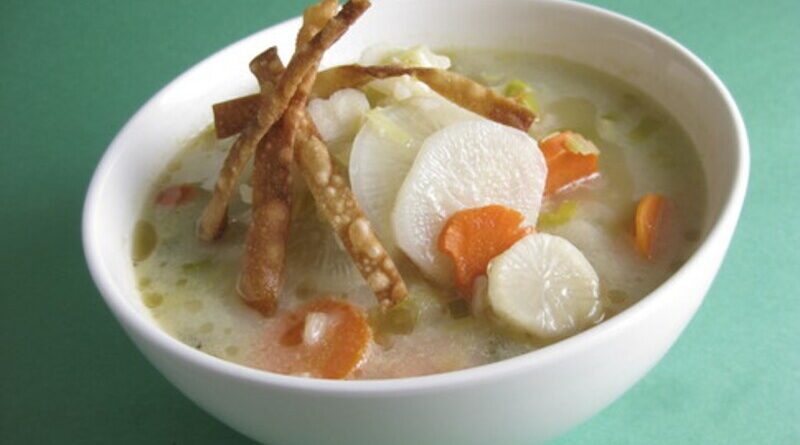Make Your Easy Yummy Chinese Daikon Soup Recipe
Welcome to the world of Chinese food, where each dish combines flavor and simplicity. We explore the essence of Chinese Daikon Soup in this article—a traditional dish that perfectly captures China’s rich culinary legacy.
Experience the healthful richness of this hearty soup, loaded with nourishing ingredients and age-old knowledge. Come along as we explore its history, preparation techniques, health advantages, and much more. Together, let’s investigate the rich tastes and cultural value of Chinese Daikon Soup.
Nutritional Benefits of Daikon
Chinese radish, or daikon, is a root vegetable that is highly valued for its mildly peppery flavor and crisp texture. This adaptable ingredient is full of vital minerals and tastes great too.
Daikon, which is high in fiber, antioxidants, and vitamin C, supports healthy digestion, strengthens immunity, and aids in detoxification. It’s a great complement to any healthy diet because of its high water content and low-calorie count. Watch this space to learn how adding daikon to your food can improve flavor and nutrients.
Chinese Daikon Soup Ingredients
| Ingredients | Quantity |
|---|---|
| Daikon | 1 large or 2 medium |
| Chicken or vegetable broth | 4 cups |
| Ginger | 1-inch piece, sliced |
| Garlic | 2 cloves, minced |
| Green onions | 2, chopped |
| Soy sauce | 2 tablespoons |
| Salt | To taste |
| White pepper | To taste |
| Carrots | 2, sliced (Optional) |
| Mushrooms | 1 cup, sliced (Optional) |
| Tofu | 1/2 cup, cubed (Optional) |
| Shrimp or chicken | 1/2 cup, cooked (Optional) |
Traditional Chinese Medicine Perspective
Daikon is highly regarded in traditional Chinese medicine (TCM) for its capacity to maintain the body’s qi (energy) equilibrium and enhance general health.
As per the principles of Traditional Chinese Medicine, daikon has a cooling quality that aids in eliminating surplus heat and moisture from the body. This makes it especially useful in hot weather or for digestive issues.
Its strong taste is thought to stimulate the stomach and spleen. Promoting better digestion and reducing symptoms like indigestion and bloating. Traditional Chinese medicine holds that you can support harmony in your body and utilize daikon’s healing capabilities by including it in your diet.
Chinese Daikon Soup Variations and Regional Influences
Chinese daikon soup is available in a variety of regional variations. Each of which gives the traditional recipe a distinctive spin. For instance, a heartier version with lamb or beef added may be found in northern China, where it’s ideal for keeping warm during the chilly winter months. Seafood, such as fish or shrimp, is frequently added to soups in the southern states to intensify their umami flavor.
For an added taste boost, some versions incorporate Sichuan peppercorns or star anise. Examining the various regional influences on Chinese Daikon Soup and choosing a recipe that suits your tastes, whether traditional or modern, is sure to be a fun culinary journey.
Chinese Daikon Soup Step-by-Step Cooking Instructions
- Peel and cut the daikon into small, bite-sized pieces first.
- The chicken or vegetable broth should be simmered over medium heat in a saucepan.
- To the pot, add the minced garlic, ginger, and sliced daikon.
- Simmer the soup for fifteen to twenty minutes, or until the daikon becomes soft.
- Add the soy sauce, chopped green onions, salt, and freshly ground pepper to taste.
- Optional: At this point, add any extra ingredients, like cooked shrimp or chicken, mushrooms, carrots, or tofu.
- To enable the flavors to melt together, boil the soup for a further five to ten minutes.
- When the soup is heated through, take out the ginger pieces and serve.
- If desired, garnish with extra finely sliced green onions.
- Savor your homemade Chinese Daikon Soup for a hearty and satisfying dinner!
Allergies and Health Concerns
Even while Chinese daikon soup is generally regarded as a wholesome and nourishing dish, it’s vital to be aware of some potential allergies and health risks. When adding soy sauce to soup, people who are allergic to soy should exercise caution.
If needed, gluten-free substitutes can be used. Those who are allergic to particular ingredients, such as onions or garlic, should also modify the recipe accordingly.
Daikon has several health advantages, but too much of it can upset some people’s stomachs, so moderation is essential. You can enjoy Chinese Daikon Soup as a nutritious complement to your meal plan by being mindful of potential allergens and considering individual dietary preferences.
Serving Ideas and Pairings
Chinese Daikon Soup is a flexible addition to any dinner because it goes well with a wide range of foods and sides. You can eat it as a satisfying meal on its own or serve it as a light appetizer before the main course.
Serve the soup with noodles or steaming rice for a full dinner and extra nutrition. The flavors and textures of the soup can be wonderfully complemented by a crisp salad or freshly steamed veggies.
Serve the dinner with your favorite Chinese appetizers or side dishes, like dumplings or spring rolls, to further improve it. Chinese Daikon Soup’s versatility and flexibility make it ideal for a plethora of inventive serving and combination ideas.
Conclusion
To sum up, Chinese Daikon Soup is a tasty and nourishing dish that highlights China’s extensive culinary heritage. It’s versatile enough to accommodate different regional variants, has a ton of health advantages, and tastes well either by itself or combined with other foods.
You Can Read More About Daikon
Discover the Secret of Korean Daikon: Unveiling Culinary Magic
